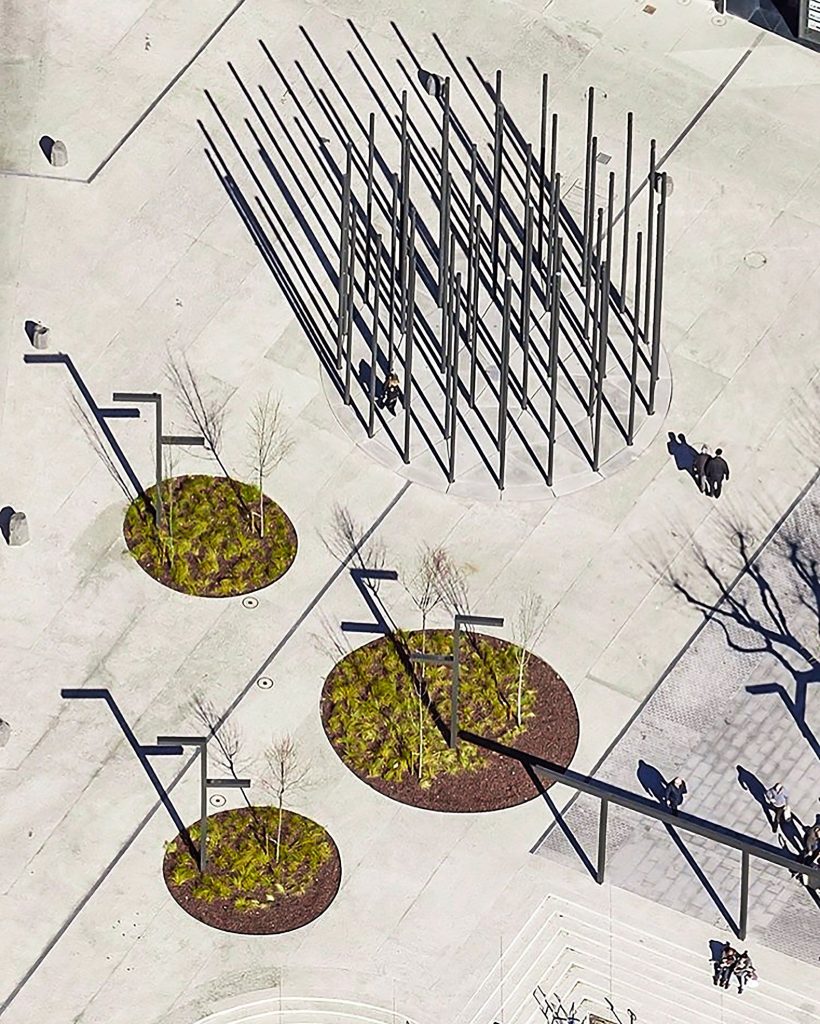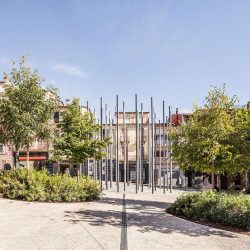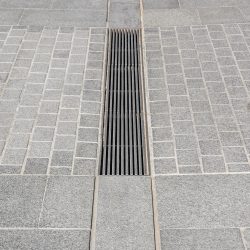
Jaume Bach . Anna Bach . Eugeni Bach . Xevi Bayona . Alba Colomer
The Miquel Blay boulevard, known as “El Firal”, and the Bisbe Guillament boulevard (El Firalet) are together one of the most emblematic places in the city. Located in the center, these two tree-lined streets contain some of the most relevant buildings in the city, including the City Hall, the Main Theater, Casa Sola-Morales and Casa Gaietà Vila.
Historically, “El Firal” was a space for meeting and coming together of the citizens. It currently hosts a large number of activities, including the weekly open-air market and the main Olot festivities such as the “Festes del Tura”, which require flexibility and versatility in this public space. In this sense, the proposal intended to reverse the situation of recent years, in which the pavement, urban elements and other pieces presented a high level of heterogeneity due to improvised solutions that had taken place across recent decades, limiting versatility and functionality.
Central to the intervention is the proposal’s elimination of road traffic on the passage, limited to what is strictly necessary and establishing a traffic strategy for nearby streets that permit pacifying this part of the city.
In order to achieve these goals, the proposal uses different existing structures to provide a new sense of functionality to this space, so representative of the city of Olot. The strategy consists of defining the limits of “El Firal” and “El Firalet”, with the understanding that these spaces are protagonists both historically and culturally in the life of the city. Thus the project proposes a series of strategies for the materials of the different pavements, urban buildings and lighting to highlight the limits of these spaces, while at the same time they are totally permeable. In demarcating the geometry of these two boulevards, the interstitial space is solved with a simple topographic movement, providing a new plaza in the city, which brings together both public spaces while providing the functional capacity required by the municipality.
This new central space between “El Firal” and “El Firalet” provides for a multiplicity of uses, thanks to its open character. It solves the topographic discontinuity, eliminating all barriers and providing for children’s play spaces, a stage and an open plaza for events of all kinds.
_
Architects: Jaume Bach, Anna Bach, Eugeni Bach, Xevi Bayona, Alba Colomer, architects. Lluís Pauné, civil engineer.
Collaborators: Angel Rico, architect.
Promoter: Municipality of Olot
Date of completion: 2022
Constructor: Rubau-Tarrés SAU
Address: Paseo de Miquel Blay, Olot, Girona, Spain.
Photographs: Adrià Goula, Eugeni Bach. Aereal photo: Eduard Masdéu
El Paseo de Miquel Blay, conocido como “El Firal”, es juntamente con el Paseo del Bisbe Guillament (el Firalet) uno de los espacios más emblemáticos de la ciudad. Ubicados en pleno centro, estos dos paseos arbolados acogen en su perímetro algunos de los equipamientos y edificios más relevantes de la ciudad, como el Ayuntamiento, el Teatro Principal, la Casa Solà-Morales o la Casa Gaietà Vila. El Firal ha sido históricamente espacio de encuentro y de reunión para los ciudadanos, y acoge anualmente un gran número de actos, como el mercado semanal al aire libre o las Fiestas del Tura, que piden flexibilidad y versatilidad a este espacio público. En este sentido, la propuesta se plantea para revertir la situación de los últimos años, donde el pavimento, el mobiliario urbano y otros elementos, presentaban una alta heterogeneidad fruto de las diferentes soluciones improvisadas que se habían realizado a lo largo de las últimas décadas, lo cual mermaba su versatilidad y capacidad de acoger múltiples funciones. Por otra parte, y como punto central de la intervención, la propuesta plantea eliminar el tráfico rodado en el paseo, limitándolo a lo estrictamente necesario y estableciendo una estrategia de sentido del tráfico en las calles colindantes que permitan pacificar esta zona de la ciudad sin problemas. Para lograr estos objetivos, la propuesta utiliza los diferentes tejidos existentes para dar un nuevo sentido a este espacio tan representativo de la ciudad de Olot. La estrategia consiste en remarcar los límites del Firal y el Firalet, entendiendo que éstos son los protagonistas tanto histórica como sentimentalmente, de la vida de la ciudad. Para ello, el proyecto plantea una serie de estrategias en cuanto a los materiales de los distintos pavimentos, mobiliario urbano e iluminación para mostrar los límites de estos espacios al mismo tiempo que los hacemos totalmente permeables. Al remarcar la geometría de estos dos paseos, el espacio intersticial se resuelve con un simple movimiento topográfico, permitiendo ganar una nueva plaza en la ciudad, que cose los dos paseos a la vez que resuelve el complejo programa funcional que requería el Ayuntamiento. Este nuevo espacio central entre el Firal y el Firalet permite una multiplicidad de usos gracias a su carácter abierto, resuelve el desnivel topográfico eliminando barreras arquitectóncias y aloja espacios como los juegos infantiles, el escenario o la plaza abierta para eventos de todo tipo.





































